Four people have served as National Jubilee Officer since Jubilee Ministry was born as a result of a resolution approved by the Episcopal General Convention in 1982. And while the ministry has changed dramatically over the intervening 30 years, some things have remained the same as ever.
Top of the list: The National Jubilee Officer’s immense pride at the range and depth of outreach efforts undertaken by the Episcopal church, and joy at the privilege of being able to see, first-hand, just what these ministries are accomplishing. That, along with a gnawing unease that what’s being done just isn’t enough.
In honor of Jubilee’s 30th anniversary, Jubilate tracked
down some past National Jubilee Officers to ask them to recall their best and worst times in the job, and to chart the evolution of Jubilee Ministry. Here are their stories:
The Rev. Peter Golden, 1985-1987
 Peter Golden was the very first National Jubilee Officer, though he wasn’t hired until nearly three years after the enabling resolution was passed.
Peter Golden was the very first National Jubilee Officer, though he wasn’t hired until nearly three years after the enabling resolution was passed.
“It was a very different environment then than it is now,” said Golden, a retired priest in the Diocese of Long Island. “General Convention had passed it as a concept, but nothing was really put into action until the next convention. So I had to come in, get things organized, acclimate, move from the Diocese of Chicago. It was quite a different understanding of what Jubilee Ministry was, and we were trying to figure out where we were going, and how fast we could get there.”
Golden recalls the early years of Jubilee Ministry as a period that lacked cohesion. A handful of ministries had been designated as Jubilee sites, but there was no sense of a national network.
At the time, Jubilee Ministry was largely controlled by other agencies within the church. A magazine was published in the name of Jubilee, but no one from Jubilee Ministry was on the editorial committee, and Golden was never advised about or consulted on articles. “That was something I fought to change,” he said.
On the plus side, Jubilee Ministry had deeper pockets in those days, and Golden developed the ongoing practice of diocesan development grants. In 2011, Jubilee Ministry provided $1,000 grants to promote the work of Jubilee Ministry to every diocese that applied. During Golden’s years, the grants were $25,000 to every diocese that applied.
“That was exciting, to hear the bishops talk about how that money was able to help so many organizations get off the ground, or save them from non-existence,” he said. “And visiting Jubilee Centers, talking with the people running those centers, that was a good and great feeling.”
During Golden’s years, Jubilee evolved from a sluggish start-up operation into a functional network that began to resemble the Jubilee Ministry it would eventually become.
The Rev. Carmen Guerrero, 1999-2006
Carmen Guerrero was the director of a Jubilee Ministry in Texas when she went to a Jubilee training conference in 1998 and learned the job of National Jubilee Officer was open.

“I started thinking maybe I could do that,” recalled Guerrera, now a semi-retired priest in the Diocese of Arizona who still coordinates multi-cultural ministries for the diocese. “I decided well, I’ll give it a shot.”
When she began in January of 1999, she was told that her job mostly was to keep track of a data base. “But I remembered having learned from Ntsiki (the previous National Jubilee Officer) that Jubilee was about advocacy, empowerment and outreach,” Guerrero said. “But it appeared to me we were just doing outreach. What happened to the other two?”
Guerrero made it her mission not only to focus on all three areas of ministry, but to expand Jubilee to a global network. “I called the archives and had them send me anything and everything that had to do with Jubilee Ministry since 1983,” she said. “I read the resolution that said we would work with poor and oppressed wherever they may be found. I had been a missionary in Latin America, so I knew where there were a whole bunch: in Province IX.”
Under Guerrero’s leadership, the Jubilee network grew rapidly, from a couple of hundred centers to over 700, in both the U.S. as well as Latin America, the Caribbean, and Asia. Guerrero called on every single one of them, either by phone or in person. Some of the ones she called didn’t even know they were Jubilee Ministries.
“Sometimes, I called and introduced myself, and they had no idea what I was talking about,” she said. “The person who had started the ministry knew they were a part of the church, but then they grew, and they forgot they were part of the church. It was like the best-kept secret.”
Guerrero began doing national Jubilee Ministry gatherings, and she started a training program for site visitors, so there would be a trained cadre of Jubilee representatives who knew what to look for in a potential new Jubilee Ministry.
She also launched a training program for Diocesan Jubilee Officers. “If we were going to be able to empower people in the field, we needed to be empowered ourselves,” she said. “And we have been.”
Guerrero’s favorite memories are of the nearly non-stop travel, and the scores of places she got to visit, the people she got to meet, and the ministries she got to see in action.
“I made it my business to visit every possible center I could, and I did,” Guerrero said. “I did a lot of traveling. And basically, I told people, ‘Don’t waste my time telling me what you’re doing. When I come, show me what you’re doing. Don’t wait until I get there and say ‘What would you like to do?’”
The Rev. Christopher Johnson, 2008-2012
Not only did Jubilee Ministry evolve during Chris Johnson’s tenure, so did the position of Jubilee Officer. When Johnson – a priest, the Jubilee Officer for the Diocese of Colorado and the director of a Jubilee Ministry – first applied for the position following Carmen Guerrero’s retirement, he was applying for the job of “National Jubilee Officer.” By the time her position was filled, it had expanded to include oversight for all of the church’s domestic poverty alleviation efforts, and his title became Officer for Social and Economic Justice.
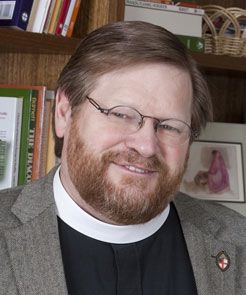
Unfortunately, Johnson took office during a time when the church center staff was downsizing dramatically. He lost much of the support staff that his predecessors had enjoyed. “I never had the advantage of an internal administrator who could actually stay focused on the internal movement of paper,” he said. As a result, he assumed far more administrative tasks – and fewer visionary leadership opportunities – than he would have liked.
But out of that forced restructuring came something good. “It reinforced for me that absolute importance of the development of grassroots leadership of Jubilee Ministry out in the field,” said Johnson. “It emphasized for me that it’s critically important that Jubilee be organized and developed externally through the network rather than internally through the office.”
Johnson readily ticks off some of his proudest accomplishments: The primary responsibility for designating ministries as Jubilee centers was shifted back to the diocesan bishops, as was always intended; Diocesan Jubilee Officers were provided with sample written agreements and job descriptions that they could endorse with their bishops, if they chose; formal rites for commissioning of new Jubilee Ministries and Jubilee Officers were developed; and an emphasis on connecting the network of ministries with each other was begun, including the launch of a quarterly newsletter, Jubilate.
“All of that is to say, really, that the emphasis has been on the grassroots nature of Jubilee Ministry, and trying to orient it to its grassroots for its health, vitality and sustainability,” he said. “That allows the work of the institutional church to remain one of affirming that which is happening and being inspired at the local level, and awarding grants as available.”
His favorite memories are of the gatherings of Jubilee Officers in Cedar Rapids in 2009 and Lexington in 2011. “Especially those work days that we did in Cedar Rapids and in Kentucky, bringing the Jubilee officers to places a little off the beaten path and giving them the opportunity to labor alongside each other while learning from each other,” he said. “And, of course, the moment Abe Lincoln stepped into our gathering in Cedar Rapids, in full attire.”
Johnson leaves the national church staff to return to parish work in Colorado, as well as the four new grandchildren born during his time in New York. But he hopes his involvement with Jubilee Ministry will not end.
“I’m just changing the nature of my relationship to it,” he said. “I leave believing that whatever is good for the network in the end will be good for the church, and will be good for me. I want to be about the building of that healthy thing.”
He parts with some words of wisdom: “Anything Jubilee Ministry becomes in the future will be based on what we do with it right now. This is a pivotal moment in the life of the Jubilee Ministry network.”
Peter Golden, 1985-1987
Ntsiki Cahane Langford, 1987-1998
Carmen Guerrero, 1999-2006
Chris Johnson, 2008-2012
Urban Ministries of Durham has a long history in the downtown Durham community, and it’s intricately linked to Jubilee Ministry.
With leadership from area faith communities, including Episcopal churches, the Urban Ministries Center was founded in 1983 as a host site for area service organizations, including St. Philip’s Community Kitchen, a ministry to the hungry founded by St. Philip’s Episcopal Church of Durham. The Durham Community Shelter for HOPE was next door.
In 2001, the Community Kitchen, the Shelter for HOPE, and the United Methodist Mission Society merged to form Urban Ministries of Durham. Today, the center runs a gamut of programs to meet the needs of the poor, the hungry and the homeless.

Among them:
• UMD’s Community Shelter has 81 beds for men, 30 for women and nine family rooms for parents and their children, for a total of 149 beds – plus an overflow section is opened on cold nights. Most beds are filled every night. In addition to providing emergency overnight shelter, UMD’s Journey Program provides longer-term shelter, a structured approach to recovery and case management for up to 400 individuals per year.
• The Community Café serves three meals a day, seven days a week, 365 days a year to shelter residents and anyone else in need of a meal. Volunteers provide over 90% of the labor to prepare the meals and community partners donate over 90% of the food. Last year, the café served an average of 600 meals per day.
• The Community Food Pantry and clothing closet addresses the basic needs of guests. Last year, the pantry distributed nearly 90,000 pounds of food, and the closet gave away nearly 42,000 items of clothing. Together, they serve about 450 individuals per month.
• The Hope-Believe Recovery program is a key component of UMD’s Journey Program. It is an intensive six-month live-in drug and alcohol rehabilitation program for adult homeless men and women. Modeled after a 12-Step Alcoholics Anonymous program, participants also receive case management support and connections to housing and employment services.
• The Bread for the Journey program seeks to meet the need for spiritual and pastoral care during times of homelessness and need. Offerings include non-denominational prayer services, support groups and opportunities for fellowship and community building.
By Elizabeth Morris Downie
DJO, Diocese of Eastern Michigan
Even before the creation in 1983 of “Jubilee Center” designations, St.
Paul’s Church, Saginaw, Mich., was deeply involved in the work of Jubilee.
The parish had sponsored the development of two urban low-income residences totaling over 200 units, operated an extensive feeding program, including Sunday dinner, and opened its facilities to numerous community organizations. The Welfare Rights Committee met there, and Planned Parenthood opened a clinic there also, becoming the first women’s health clinic in the City of Saginaw.
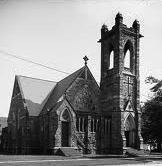
In the past 30 years, the specifics of mission and ministry have evolved, but the work of Jubilee remains central to St. Paul’s parish life.
So it was an easy “yes” to Bishop Coleman McGehee’s invitation to
The Rev. Bill Boli, rector, to apply for the Jubilee Center designation.
In the past 30 years, the specifics of mission and ministry have evolved, but the work of Jubilee remains central to St. Paul’s parish life.
Boli served two terms on the national Board of Jubilee Ministries, and also served “more years than I care to count” as the diocesan Jubilee minister.
Planned Parenthood has moved to its own clinic space, and the
ecumenical cooperation of a neighboring parish has faded, necessitating some reduction in the number of days the feeding program can be offered. But Sunday dinner is still a major event, with 15 different congregations hosting and serving the meal in rotation, while St. Paul’s provides crowd control and pastoral care. Absolutely all are welcome to this dinner.
In addition, bag lunches are offered three times a week; the lunches are furnished by the women of St. Thomas Aquinas Roman Catholic Church.
St. Paul’s also offers a School of Biblical Studies, with a particular
emphasis on Christian social interaction, addressing the issue of violence affecting the lives of those who come. There’s a food pantry, of course, and the “Healthy Futures Free Clinic,” staffed by Caroline Scott, MD, a very active member of the congregation, and a nurse from St. Mary’s Medical Center.
This clinic serves people without insurance, and offers HIV testing.
Along with this physical health care, the parish offers a healing meditation garden for spiritual healing.
Since there is no public transportation on weekends and very little in
the evening in the Saginaw, the parish worked to acquire a van to bring parishioners to services and to weeknight activities.
Always alert to the needs of the people it serves, St. Paul’s Church is
now exploring ways to address the difficulties many urban children have learning to read. The current rector, The Rev. Judith Boli, is a retired educator, and she is evaluating the potential of reading “toys” to help children learn that reading is not only possible, but fun.
“We are Church,” Judith Boli says. “Everything we do is centered around the altar.” And the centrality of faithful worship is resulting in growth; since 2008, average Sunday attendance has risen by 20 percent, to 98.
St. Paul’s welcomes those who are outcasts from other churches; people with developmental or emotional difficulties often cannot keep the code of quiet behavior expected in most churches, but they are welcome to stay as long as they don’t make so much noise that the rest of the congregation can’t hear the priest.
Children of all ages are present for the entire service. A
gospel choir provides enthusiastic musical leadership in a wide variety of styles, including rap, for worship.
Like many cities in Michigan, Saginaw has been hard hit by economic
downturns and loss of jobs, rising crime rates and a shrinking tax basis, but in the center of this city, St. Paul’s Episcopal Church is a beacon of hope and light, truly striving through the years to help Saginaw become a Jubilee city.
By The Rev. Dee Calhoun
DJO, Diocese of Central Pennsylvania
The development of Jubilee Ministry as the guiding concept of mission at St. Mark’s Episcopal Church, in Lewistown, Pa., was the direct result of two significant circumstances.
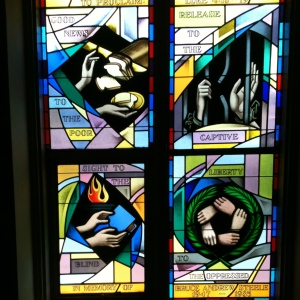
The Jubilee Ministry stained glass window at St. Mark’s spells out in beautiful color just what Jubilee Ministry is all about.
In 1972, Hurricane Agnes brought massive flooding and destruction to the Lewistown area. Then, as a consequence of the flooding, one major industry shut down its operation altogether, and another was forced to dramatically reduce its work force. Additionally many homes in the downtown area were either severely damaged or destroyed. People in the area were left reeling, many were unemployed and others had lost all that they had.
The people of St. Mark’s joined with others in the community to try to do all they could to provide relief and support for those in greatest need. In 1976 St. Mark’s called a new rector to replace the rector of many years who was leaving to accept a new call.
The Rev. Peter Greenfield presented a vision that challenged the people of St. Mark’s to change the focus of their mission from “in reach” to outreach. The people responded to that challenge by engaging in the work of a Center for Jubilee Ministry, even though the term had not yet been coined or the concept formalized.
Under his leadership, with the support and help of several parishioners, Fr. Greenfield launched a series of programs to help those in the community who were struggling. A community garden provided folks with fresh produce. Meals on Wheels set up its operation in St. Mark’s kitchen. Mother Hubbard’s Cupboard, a community food bank, was opened in the undercroft of the church.
The parish initiated community work weeks to provide labor and materials to assist with badly needed home repairs and painting for those in the community who could not manage to do the work themselves. Ecumenical relationships and partnerships were formed with other denominations to provide political, social and spiritual advocacy for individuals and organizations needing sponsorship.
A strong youth program was established that provided an outlet for young people seeking a place to belong. And many, many visits to comfort and encourage and restore people in despair throughout the county were undertaken. St. Mark’s truly announced “a year of favor from the Lord” in both word and deed.
Not long after, the idea of establishing a specific new ministry in The Episcopal Church, based on the concept of Jubilee (the renewal of a strong commitment to a season of sharing God’s blessing, compassion and goodness, from a sense Christian purpose and justice) was initiated.
At that time, The Rt. Rev. Charlie F. McNutt, Bishop of the Diocese of Central Pennsylvania, believed that St. Mark’s, Lewistown embodied this kind of ministry. At Bishop McNutt’s urging, St. Mark’s applied to be recognized as a Jubilee Center for outreach Ministry and was the very first Parish in the U.S. to receive this designation. The then-Presiding Bishop, Rt. Rev. John Allin, came to St. Mark’s personally to present the certificate.
In the late 80’s, under the leadership of a new rector, St Mark’s recommitted to the concept of ministry by establishing a Jubilee Chapel. The Window in the Chapel speaks the Jubilee Message to all who enter.
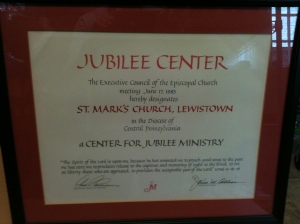
The certificate proclaiming St. Mark’s, Lewiston, as a Jubilee Ministry is still displayed at the church. Note the date: June 17, 1983.
Today the concept of Jubilee is still the guiding principle for ministry at St. Mark’s. In fact, the parish recently received a grant of $20,000 from the diocese to reclaim and strengthen its identity as a center for Jubilee Ministry in light of changing circumstances.
As economies and demographics shift in Central Pennsylvania, so does the emphasis of the Center. Today the Center orients its activity around five major areas:
1. Mother Hubbard’s Cupboard has become the principal food pantry in Mifflin County (open four days per week).
2. The parish extends a spirit of intentional hospitality in its Breaking Bread Together community dinners that provide not only opportunity for a balanced meal table served by volunteers but also much needed fellowship for over 100 individuals and families in the immediate area.
3. Parishioners’ Outreach provides emergency assistance to persons in economic crisis (rent, fuel, electricity, and other critical services).
4. Environmental Stewardship advocates for “green thinking” on a practical level by providing educational opportunities for the wider community on how to care for and preserve our physical environment in everyday ways.
5. Folks of a Certain Age is the Center’s newest program designed to address issues confronting people 55 years and older from a faith based perspective, as the median age of the area increases rapidly.
St. Mark’s Jubilee Ministry Center continues to forge partnerships with local agencies and other churches. Many of the volunteers that staff the various programs come not only from St. Mark’s but also from local congregations. Financial and in-kind support comes from religious groups throughout the area on a regular basis.
The Jubilee Ministry Center at St. Mark’s thereby provides a kind of “hub” where many individual efforts intersect to create a genuine sense of the Lord’s Year of Jubilee.
By The Rev. Becky Jones
DJO, Diocese of Colorado
Today, the St. Francis Center in Denver is a long-established refuge for homeless men and women in Denver, providing a place where up to 800 individuals a day may come to shower, get a change of clothes, see a doctor, store their belongings, get their mail or simply find a place of warmth and safety during the daytime when they have nowhere else to go.
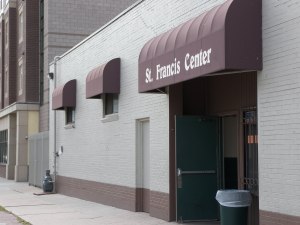
The St. Francis Center moved into its current home in 1985, in a once-seedy but now fashionable part of Denver.
But in early 1983, such a place was still just a vision that the Rev. Bert Womack had. Womack, the now-retired Canon to the Ordinary in the Diocese of Colorado, had founded the Pastoral Care Center, which served as an umbrella organization to several diocesan and community outreach agencies.
It was the Pastoral Care Center that was invited to become one of the first eight charter Jubilee Ministries in the Episcopal Church. Within in a year, the Pastoral Care Center had morphed into the St. Francis Center, a diocesan-sponsored day shelter for the homeless. Meanwhile, Central Denver Community Service, one of the agencies that shared space under the Pastoral Care Center roof, eventually became Metro CareRing, a large food bank and emergency services agency. Metro CareRing continues to be heavily supported by Episcopalians in Denver and it, too, became a Jubilee Ministry, one of 27 now operating in the diocese of Colorado.
The St. Francis Center grew out of the Colorado diocese’s desire to respond appropriately to the changing needs of Denver’s poor.
“As these programs developed, we began to start seeing a whole different population,” said Womack. “Our clients were no longer just the single mothers with two kids. We were seeing the chronically mentally ill, and they didn’t have anywhere to go. They were coming to us to see if they could get help.”
“Their needs weren’t the same as the single mothers,” he said. “This new population just wanted a place to be warm, to get a shower. We began to look at that, and in early 1982 we realized there was nothing in the metro area that would begin to address those needs.”
And that’s how the St. Francis Center was born. In June 1983 the diocese leased a building in a seedy part of town, rehabbed it minimally, put together a staff and opened the doors. “Initially, we were seeing 50 to 60 people a day,” recalled Womack, who served as the first executive director from 1983 to 1994. “By the end of the year, we’d outgrown the place.”
Womack remembered that first St. Francis Center facility none too fondly. “There were two showers, one of which might work,” he said. “There were two toilets, both of which rarely worked. We were constantly trying to just keep things going.”
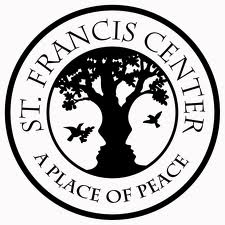
“So much was just trial and error to determine what worked and what didn’t work,” he said. “The one thing we did, we had a minimum of rules. But we enforced the ones we had, and the population honored that.”
Parishes around the diocese embraced the St. Francis Center. Women’s groups held “potty parties” to collect toilet paper and other toiletry needs. Others hit the rummage sales to collect used blue jeans. “Places like Vail and Aspen would bring truckloads down to us,” Womack said.
An 18-month capital campaign raised a million dollars, which made it possible for the diocese to buy a new building, debt-free. That building, at 2323 Curtis Street in Denver’ once-seedy but now fashionable Curtis Park neighborhood, continues to house the St. Francis Center.
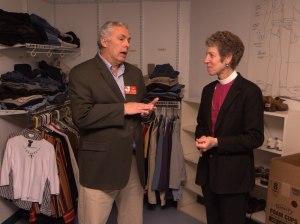
Presiding Bishop Katharine Jefferts Schori visited the St. Francis Center in November, 2012. Here, she’s touring the clothing room with executive director Tom Luehrs.
“It’s been rehabbed and changed over the years to meet the needs,” Womack said. “And the population we’re serving has increased steadily. When I see what they’re doing today at the St. Francis Center, I am just staggered.”
Last year, total visits by guests to St. Francis Center were 225,904 with a daily average of 622 different individuals, though there were as many as 779 visitors on the busiest day. In total, 9,352 different guests were welcomed over the course of the year.
The shelter distributed more than 90,000 articles of clothing in 2011; placed 814 clients into jobs, including 42 full-time jobs; registered 3,242 visits to the Stout Street Clinic, located within St. Francis Center; provided access to 443 units of housing; the center’s outreach team logged 12,018 encounters with homeless individuals; and logged 16,159 volunteer hours.
Almost three years ago, Cornerstone Residences at St. Francis Center, a permanent supportive housing community, opened next door to the day shelter, providing 50 apartments and case management for the chronically homeless, and capping another of Womack’s longtime dreams.
When the Pastoral Care Center was first recognized as a Jubilee Ministry, Womack took to heart the promise he made to help others replicate what was happening in Denver. “The intent at the time was to establish a Jubilee Center in each diocese, and those Jubilee Centers were to spawn other direct service ministries through their diocese,” he said.
Over the years, the St. Francis Center has helped set up 16 direct-service agencies throughout Colorado, including several – Good Samaritan Center in Cortez, Cooperating Ministries of Logan County in Sterling, Caring Ministries of Fort Morgan, and Crossroads Ministry of Estes Park – that today are themselves Jubilee centers.
“It hit a chord in people in the church,” said Womack, who is now retired. “Congregations began to look at social outreach a little more seriously. And I was very pleased that we had something to offer back to others.”
If Jubilee Ministry were a person, it probably would have started thinking about settling down, putting aside youthful excess, and planning for the future by now.
It was 30 years ago, at the Episcopal General Convention meeting in New Orleans, that delegates finally approved Resolution A080, which established Jubilee Ministry as “a ministry of joint discipleship in Christ with poor and oppressed people, wherever they are found,
to meet basic human needs and to build a just society,” concluding that this “is at the heart of the mission of the church.”
Since then, the General Convention has reaffirmed its commitment to Jubilee Ministry eight times, including at this past convention in Indianapolis in July. Resolution D094, adopted this year, resolves that Jubilee Ministry “be affirmed as a vital expression of the type of relational ministry that is being called forth from local congregations of the church today as they seek to reconcile all people to unity with God and each other in Christ.”
Since the enabling legislation that created Jubilee Ministry and the network of Diocesan Jubilee Officers was adopted, more than 600 Jubilee Ministry centers have been identified.
But in the beginning, there were eight, affirmed by Executive Council in June, 1983:
• St. Mark’s Episcopal Church in Lewistown, Pa.
• The Episcopal Pastoral Center in Denver
• St. Paul’s Episcopal Church in Saginaw, Mich.
• Urban Ministries of Durham, N.C.
• Holy Cross Episcopal Church in Miami
• East St. Louis Metropolitan Ministry in East St. Louis, Ill.
• Episcopal Ministries of Middle Tennessee/Urban and Regional Ministry in Nashville
• Urban Mission Training Program in Washington D.C.
Of these eight, five remain in one form or another, and they’re continuing to do the work of Jubilee.
In this issue of Jubilate, as we seek to celebrate 30 years of Jubilee Ministry, we’ll profile some of these original Jubilee Ministries. We’re also checking in with former National Jubilee Officers to share some of their favorite memories and their observations on how Jubilee Ministry has changed through the years.
Happy anniversary, Jubilee Ministry! May the next 30 years be even more productive!
By Canon Heidi Shott
DJO, Diocese of Maine
In 2010, a loosely-organized group of laity and clergy from the Episcopal Diocese of Maine came together in response to the call of the Episcopal Church U.S.A. 2009 General Convention Resolution A155 for the church to “recognize the pressing challenges to those living in poverty and the working poor throughout this nation.”
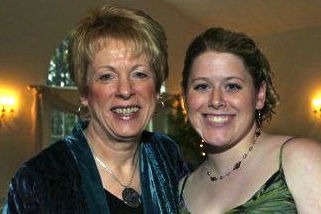
The Rev. Heather Blais, right, with her mother the Rev. Rebecca Grant, a deacon at St. Mark’s Episcopal Church in Augusta, Maine.
At the same time, a priest-in-formation, Heather Blais, was settling on a project for her senior year at Bangor Theological Seminary. The group, which became known as the Domestic Poverty Working Group and included the Rev. Mary Lee Wile, the coordinator of the Deacon Formation Program; the Rev. Shirley Bowen, the executive director of Seeds of Hope Jubilee Center in Biddeford; and Canon Heidi Shott, Canon for Communications and Social Justice met with Heather and the blue-sky conversation began.
What quickly became evident is that in the body of Christ all people have different roles and gifts to share. While we are all called to serve, some are drawn to ministry and advocacy that works to eliminate the root causes of injustice and poverty. Justice is their primary focus. Others are gifted with meeting those in need where they are – directly ministering those in immediate need. Mercy is their calling. Fighting poverty in Maine and beyond requires both types of people and two sets of resources.
It became clear to the group that it would be helpful to have a web-based resource that connected those of all faith traditions to organizations that are already working to end domestic poverty here in Maine. As this idea evolved it became JusticeandMercyME. Blais had her senior project and a ready-made group of supporters.
Launched in March 2011, JusticeandMercyME is a web-based resource that seeks to encourage and empower people of all faith traditions to join in the battle to end domestic poverty here in Maine. In order to put an end to domestic poverty we need to be engaged in acts of mercy by meeting the needs of the here and now. Those that are battling hunger and homelessness in our community need food and shelter today. There are some amazing organizations, ministries, and communities finding innovative ways to meet the needs of the here and now in Maine and across the country.
At the same time, in order to put an end to domestic poverty we need to make systemic changes. We need to eradicate the roots of domestic poverty. In order to do that we need to engage in the work of justice. There are some amazing organizations, ministries, and communities finding equally innovative ways to make systemic changes in our society. Changes that could eradicate domestic poverty.
JusticeandMercyME, through both its web presence and its Facebook page, seeks to help connect the people of Maine with these great organizations, communities, and ministries. The site includes contact information and links for more information encompass the topics of hunger, homelessness, and everyday necessities at the state and national level.
According to Mary Lee Wile, “Deacons are often at the heart of the ministries that focus on mercy: Chick Carroll helped establish the Gathering Place, a homeless day shelter, in Brunswick. Dick Rasner (who will be ordained in June) is the volunteer director at St. Elizabeth’s Essentials Pantry in Portland. Many deacons are involved in feeding programs, some work with at-risk kids, some with the mentally ill, others engage in prison ministries where many of the incarcerated have dealt with poverty and will be released back into poverty. Over 30 deacons showed up in October to learn from DHHS how to help those among whom we minister access available programs.”
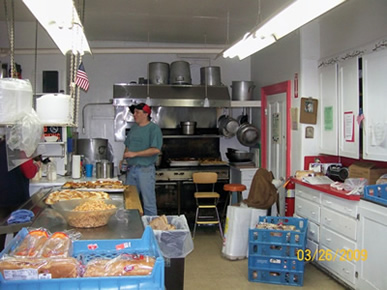
For nearly 20 years Trinity Jubilee Center has served daily meals to the people of the downtown Lewiston. Here Chad Jacobs prepares for another day.
JusticeandMercyME’s blog, which continues to be maintained by Blais, who is now Assistant Priest at St. Philip’s, Wiscasset, and Grace Church, Bath, serves to share other news, events, ministries, and organizations that address ending domestic poverty here in Maine. We believe that if we each “Do justice, love mercy, and walk humbly with your God” that we can fulfill the hope of ending domestic poverty.
Heidi Shott is Canon for Communications and Social Justice in the Episcopal Diocese of Maine.
By Bill Lindsay
Over the past six years, clergy and parishioners of St. John’s Episcopal Church, Lynchburg, VA, have fostered a caring relationship with Holy Cross Anglican School on Ambergris Caye in Belize, Central America.
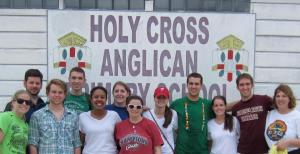
Parishioners at St. John’s Episcopal Church in Lynchburg, Va., have formed a caring relationship with Holy Cross Anglican School in Belize.
San Mateo lacks proper water service, adequate road infrastructure and sufficient energy distribution. Built within mangrove swamps, the garbage-laden landfill materials used to create islands and improper waste disposal poses a very serious health hazard. According to The San Pedro Sun News, a local newspaper, environmentalists believe the area may well be a “catastrophe in waiting.”
Holy Cross Anglican School was founded in 2006 to provide an education to the island’s poorest children. Before the school was founded, many of these children simply roamed the beaches, sold jewelry to tourists and had little hope of a brighter future. It was started with a patch near a lagoon with the help of donations and teams of volunteers. The school was built with 16 classrooms, a library, computer lab, dental clinic, and a cafeteria where a hot nutritious lunch is served – for some, the only regular food they receive. There is also a preschool.
Holy Cross School educates and feeds more than 425 children. Each visiting group is asked to bring a project fee to meet the needs of students whose families cannot afford the cost of school tuition. Last year, St. John’s was responsible for sending a total of $14,000 through project fees, donations, and matching grants. Of this total, $1,000 was from a Jubilee Diocesan Development Grant and this was matched by another $1,000 from the Holy Cross Foundation.
St. John’s interest in San Mateo began six years ago with Ann Vest, a member of this parish, in her work with Episcopal Relief and Development, together with a Lynchburg couple, Francis and Vernon Wilson. In subsequent years, intergenerational groups from St. John’s have made mission trips there, often more than one a year. Ann Vest recently took a third grandson there. These groups tutor students, and help with painting, building and property improvement.
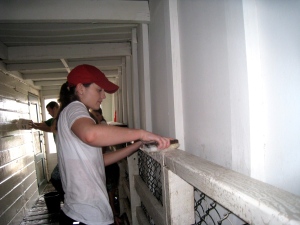
Canturbury Club members at Lynchburg College have made “alternative Spring Break” trips to Holy Cross, tutoring students and working on poverty improvement projects.
Still another group that has adopted Holy Cross School as a mission destination is the Canterbury Club of Lynchburg College. Canterbury Clubs are ministries of the Episcopal Church at colleges throughout the United States. This club is a ministry of St. John’s, the Episcopal Diocese of Southwestern Virginia, and the Lynchburg Convocation of Episcopal Churches. Led by Faculty Advisor Nina Salmon, Assistant Professor of English and The Rev. Mark Furlow, a member of the Lynchburg College ministries team, they have made two alternative Spring Break trips, tutoring students and working on property improvement projects at the school. Students report that they are thrilled to be helping the children of Belize and they bring back knowledge to share with classmates and their parishes.
Despite working with some most at-risk children on the island, the school still ranks in the top third in primary school exams. Also, in a country where only 25 percent of children finish primary school, nearly 80 percent of Holy Cross students go on to high school. In Belize, the government pays only the teachers’ salaries and for textbooks – all other costs must be raised by the school. School officials report they could not do what they do for the children without the generous support of individuals and groups like St. John’s and the Lynchburg College Canterbury Club.
For more on Holy Cross Anglican School, visit their website www.holycrossbelize.org.
Bill Lindsay is DJO of the Diocese of Southwestern Virginia.
